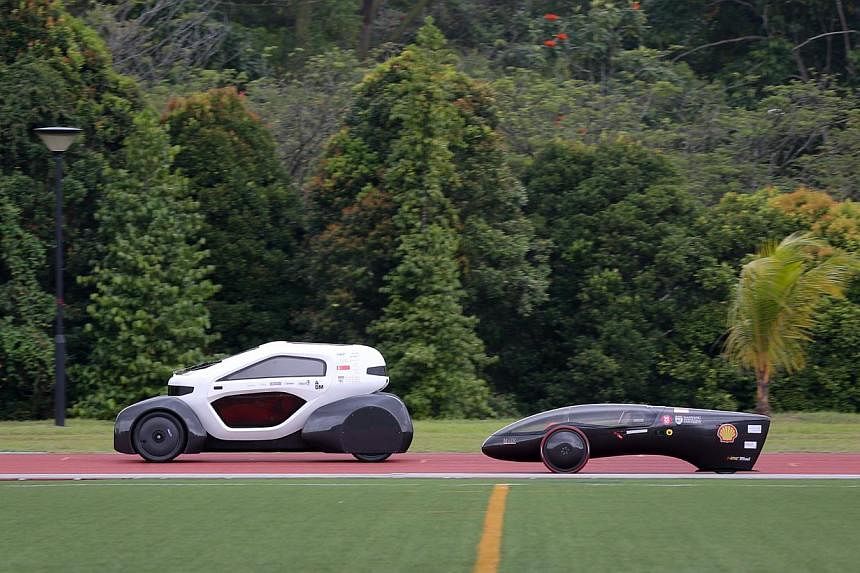How far can one litre of fuel take you?
Two teams of Shell scientists in the USA tried to answer this simple yet intriguing question in 1939 with a friendly bet. They each filled their cars with one gallon of petrol and drove to see who could go farther. The winner managed 50 miles per gallon, or 21 kilometres per litre.
Fast forward to today and the challenge lives on in the Shell Eco-marathon, which returns to Manila this month, beginning on Feb 26. Testing the ingenuity of student engineers, we ask them to design, fund and build a car that can travel over the longest possible distance on the least amount of energy. In short, do more with less.
How impressively they respond. This year, Singapore will send two teams from Nanyang Technological University and one from the Institute of Education. The NTU teams have actually built Singapore's first urban solar electric car with an innovative 3D-printed body shell that has 150 parts. A second vehicle, a racer, has hand-crafted silicon solar cells and wheels that take sharp corners with little loss in speed due to its unique tilting ability inspired by motorcycle racing.
But the more significant strides, particularly in Asia, are those being made away from the track, in extending Shell's reach into the region's talent pool to inspire a new generation to find potentially game-changing ways to produce energy.
The overall stock of scientists and engineers in Asia remains smaller than the combined total in the USA and Europe. This is a critical issue for our business. In India, for example, we are building a new, advanced technology centre, one of three around world, which will house up to 1,500 experts by the end of this year.
Growing the pool of talented young Asian engineers and scientists will be essential in helping the region meet one of its biggest challenges: supplying enough energy to maintain economic prosperity while tackling potentially devastating climate change.
By 2050, the urban population in Asia is expected to soar from 1.9 billion to 3.3 billion, meaning rising demand for energy to power high-rise apartments, public transport networks, and mobile devices.
A growing number of Asians living in cities will also be buying their first cars. In China, the number of motor vehicles could grow to between 560 million and 730 million by 2050, more than two to three times the number in the USA, the biggest market for vehicles in the world, according to a report by the US Department of Energy.
But how do we balance this surge in energy use with our need to reduce carbon dioxide emissions? Part of the solution will involve a radical change in the global energy system, with a wider mix of sources including cleaner-burning fuels.
The answers, however, won't come from a single country or company. The breakthroughs will likely be the result of new ways of thinking, with collaboration between the private sector, academia and the government.
Innovators don't surface by chance. They have to be discovered, encouraged and challenged. Shell hosts a series of global competitions aimed at doing just that. The Shell Ideas360 contest, for example, encourages students around the world to conceive, share and develop game-changing ideas to improve the availability of energy, food and water.
The Shell Eco-marathon is another crucible of innovation. In a survey after last year's Shell Eco-marathon Asia in Manila, more than 90 per cent of contestants said they gained additional skills critical for their new careers. Around the same number of students said taking part also inspired them to pursue jobs in science and engineering where they could continue to tackle energy challenges.
The contestants come from an increasingly diverse background. When the first Shell Eco-marathon Asia was held in Malaysia in 2010, for example, there was no team from Vietnam. But this year, nine teams from seven universities in Vietnam will take part.
This growing diversity adds depth to the science and engineering talent pool that will be an asset for Asia in the future.
Several contestants from the Philippines, Pakistan, Brunei and Singapore have gone on to work for Shell. In 2011, Nanyang Technological University student Lim Weison and his team won in the Prototype (Diesel) category. In 2012, they participated again and achieved first runner-up in the Prototype (Diesel) category. In July 2013, he joined Shell Jurong Island as a mechanical plant engineer. Call him one of SEM's success stories.
For Shell, this is more than just smart hiring policy. It represents a broader strategic shift towards Asia where we believe in developing local talent to meet the region's rising energy needs.
A litre of fuel, it turns out, can carry us all a long way.
The writer is Chief Human Resources & Corporate Officer of Royal Dutch Shell.

